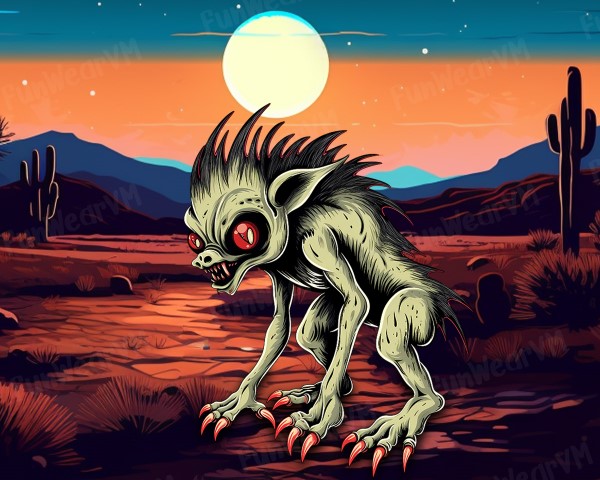
Chupacabra is a mythical creature that is said to attack and drink the blood of livestock, especially goats. The name chupacabra comes from the Spanish words chupar (‘to suck’) and cabra (‘goat’), and can be translated as ‘goat-sucker’. The legend of the chupacabra has been spreading throughout the Americas since the 1990s, and has inspired many stories, movies, and even video games. But what is the origin of this mysterious beast? And is there any truth behind the sightings?
The History of the Chupacabra
The Chupacabra stands as a captivating figure in the realm of modern cryptozoology, a creature whose notoriety has spread rapidly across the Americas and even to distant corners of the globe.1 This enigmatic entity is perceived in contrasting ways, evoking fear and terror in some communities, while simultaneously serving as a subject of intense folklore and rigorous scientific investigation for others.1 This comprehensive information page aims to explore the multifaceted phenomenon of the Chupacabra, providing an engaging and detailed overview of its history, physical characteristics, reported behaviors, cultural impact, and the various scientific explanations proposed for its existence.
The relatively recent emergence of the Chupacabra narrative in the mid-1990s 2 sets it apart from more established cryptids with longer historical roots. This recency, occurring within an era of widespread mass media and the burgeoning internet, likely played a significant role in the swift dissemination of the legend compared to cryptids with more localized and ancient origins. Furthermore, the very name “Chupacabra,” translating from Spanish as “goat-sucker” 5, immediately establishes its primary alleged activity and target, profoundly shaping the initial public perception of this mysterious creature.
The Chupacabra legend first gained significant traction in Puerto Rico in March 1995.2 Initial reports detailed the unsettling discovery of livestock, primarily sheep, found dead with their blood seemingly drained and bearing peculiar puncture wounds.2 While these 1995 incidents marked the true beginning of the Chupacabra’s widespread fame, earlier events in Puerto Rico, specifically the “Vampiro de Moca” livestock killings in the 1970s 2, are often cited as a possible precursor to the Chupacabra phenomenon. These earlier attacks, also characterized by blood-drained animals, initially fueled speculation about satanic cults or large vampire bats.18 Following the initial surge of reports in Puerto Rico, the Chupacabra narrative rapidly spread to other countries across Latin America and into the United States.2 Media played a crucial role in this dissemination, with news outlets widely reporting the incidents and the term “Chupacabra” being coined by Puerto Rican comedian Silverio Pérez shortly after the first reports surfaced in the press.2
The timing of the first major Chupacabra sightings in Puerto Rico in 1995 coincides remarkably with the release of the science-fiction horror film Species.2 The initial descriptions of the Chupacabra, often depicting a reptilian, bipedal creature with spines, bear a striking resemblance to the alien creature “Sil” featured in the movie. Eyewitness Madelyne Tolentino, who provided one of the earliest and most detailed descriptions, even acknowledged having seen the film prior to her report, noting the impressive similarity between the movie monster and the creature she claimed to have encountered.2 This temporal alignment strongly suggests a potential influence of popular culture on the early eyewitness accounts, indicating a possible case of cultural contamination shaping the initial perception of the cryptid. Over time, the Chupacabra’s described appearance underwent a noticeable transformation. While early reports emphasized the reptilian biped, later sightings, particularly in the United States, described a smaller, hairless, canine-like creature that moved on all four legs.2 This evolution in the creature’s depiction suggests either that multiple distinct phenomena were being attributed to the single label of “Chupacabra,” or that different factors influenced eyewitness accounts as the legend expanded geographically. The initial fear and intrigue surrounding a mysterious, blood-draining monster likely led individuals encountering unusual animals to interpret their sightings within the framework of the prevailing Chupacabra myth.
The physical characteristics attributed to the Chupacabra vary considerably depending on the time and location of the reported sighting. Early accounts, particularly from Puerto Rico and Hispanic America, often describe a “reptilian” or “alien-like” creature.2 This version is typically portrayed as being roughly the size of a small bear, standing between three and four feet tall.2 Its skin is often described as leathery or scaly, with a greenish-gray or even blue hue.2 A prominent feature in these early descriptions is a row of sharp spines or quills running along its back.2 The head is said to be oval-shaped with large, red or black glowing eyes, and the creature possesses noticeable fangs, sometimes accompanied by a forked tongue.2 Its mode of locomotion is frequently described as bipedal, with a distinct hopping gait similar to that of a kangaroo.2
In contrast, a “canine-like” description of the Chupacabra emerged and became more prevalent, particularly in reports from the Southwestern United States.2 This version is typically similar in size to a dog or coyote 5 and is characterized by a mostly hairless body, a pronounced spinal ridge, unusually prominent eye sockets, sharp fangs, and claws.2 Its movement is generally described as quadrupedal.18 Beyond these two primary forms, other less common descriptions have surfaced, including mentions of bat-like wings, the presence of fur, or the absence of a tail.2 The sheer diversity in these physical descriptions across different times and locations 2 presents a significant challenge to the idea of a single, consistent Chupacabra creature. The wide range of reported appearances, encompassing both reptilian and mammalian traits, makes it highly improbable that all sightings can be attributed to the same biological entity. This variability strongly suggests the influence of misidentification, exaggeration, or the impact of cultural expectations on what witnesses believed they observed.
The initial cluster of Chupacabra reports originated in Puerto Rico in 1995.2 The legend then rapidly spread throughout Latin America, encompassing countries such as Mexico, Brazil, Chile, Argentina, Bolivia, Colombia, Dominican Republic, El Salvador, Honduras, Nicaragua, Panama, and Peru.2 Sightings were also reported in the United States, with reports documented as far north as Maine and concentrated in the Southwestern states, including Texas and Florida.2 Notably, there have even been isolated reports from regions outside the Americas, such as in Russia and the Philippines.2 The initial concentration of sightings in Puerto Rico, followed by a subsequent dispersal across the Americas 2, suggests a potential point of origin for the legend, with later reports possibly influenced by the initial accounts and extensive media coverage.
The following table summarizes some of the reported Chupacabra sightings in North America, providing a timeline and brief descriptions:
| Date | Location | Description (brief) | Snippet ID(s) |
| 1975 | Moca, Puerto Rico | Livestock killings, wounds | 7 |
| March 1995 | Orocovis, Puerto Rico | 8 sheep dead, blood drained | 7 |
| August 1995 | Canóvanas, Puerto Rico | ~150 animals dead | 2 |
| November 1995 | Caguas, Puerto Rico | Reptilian, hairy arms, red eyes | 20 |
| December 1995 | Naguabo, Puerto Rico | Rabbits dead, holes in neck | 20 |
| December 1995 | Klamath Falls, Oregon | Heifer mutilated, no blood | 20 |
| January 1996 | Isabella County, Michigan | 8 calves dead, some skinned | 20 |
| 2000s onwards | Southwestern United States | Hairless, canine-like | 2 |
| 2007 | Cuero, Texas | Canine-like, roadkill | 3 |
| 2022 | Amarillo Zoo, Texas | Canine-like | 7 |
The primary reported behavior associated with the Chupacabra is its alleged attacks on livestock, particularly goats, with the claim that it drains blood from their carcasses.2 These attacks are often characterized by the presence of small puncture wounds, sometimes described as three distinct holes.2 However, the assertion that the Chupacabra completely drains the blood from its victims has not been scientifically verified.2 Other reported behaviors include bipedal movement and hopping, climbing abilities, and suggestions of rudimentary intelligence or stealth in evading capture.24 Vocalizations attributed to the Chupacabra are hissing, screeching, or growling sounds.17 Notably, there is a lack of credible evidence regarding unique footprint patterns that can be definitively linked to the Chupacabra.2
The reported feeding behavior of the Chupacabra, particularly the claim of blood-draining through small puncture wounds without extensive tissue damage 2, is not typical of known predators in the Americas. Standard predators typically kill and consume their prey, leaving behind more significant signs of feeding. The Chupacabra’s alleged method of simply extracting blood through small holes is unusual and has not been consistently confirmed by scientific examinations of animal carcasses. Furthermore, the shift in reported physical characteristics of the Chupacabra over time did not lead to a corresponding change in its primary reported behavior – the attacks on livestock and the supposed draining of blood.7 This suggests that the label “Chupacabra” became associated with a particular type of unexplained animal death rather than a consistent observation of a specific creature. Regardless of whether witnesses described a reptilian biped or a hairless canine, the central element of the Chupacabra narrative remained the mysterious killing of livestock with the perception of blood loss.
The Chupacabra has become a significant modern monster in Latin American folklore.8 It serves as an explanation for unexplained livestock deaths and other mysterious events, particularly in rural communities.15 In some cultures, it functions as a boogeyman figure, used to frighten disobedient children.3 The Chupacabra has also permeated popular culture, appearing in numerous books, movies, television shows, and various forms of merchandise.1 Examples include the film Species, the comic book series Proof, and the more recent Netflix movie Chupa.7 Chupacabra-themed items can even be found in cryptozoology museums 48 and as popular souvenirs.5 Its cultural significance can be compared to that of other well-known cryptids such as Bigfoot and the Loch Ness Monster, all of which capture public imagination and spark ongoing debate about the possibility of undiscovered creatures.1
The rapid integration of the Chupacabra into Latin American folklore 3 underscores the cultural need to interpret unsettling or unusual occurrences, particularly in rural areas where livestock are essential for livelihoods. The swift adoption of the Chupacabra as an explanation for animal deaths suggests a pre-existing cultural context where such events might be attributed to supernatural or mysterious forces. The Chupacabra provided a contemporary figure to fulfill this explanatory role. Furthermore, the Chupacabra’s evolution in popular culture, transitioning from a purely terrifying monster to sometimes a more sympathetic or even humorous character 7, reflects a potential shift in public perception and a degree of domestication of the legend over time. This kind of transformation is common with many legendary creatures as they become more deeply embedded in popular imagination.
The most widely accepted scientific explanation for Chupacabra sightings points to the misidentification of known animals, particularly coyotes, dogs, or raccoons, afflicted with the parasitic disease mange.2 Mange, caused by microscopic mites burrowing into the skin, can lead to significant hair loss, thickened and wrinkled skin, and an overall gaunt and unhealthy appearance that aligns with many descriptions of the Chupacabra, especially the later canine variety.2 The disease can also affect the behavior of infected animals, making them weaker and more likely to seek out easier prey, such as confined livestock.2 The puncture wounds reported on the livestock could be consistent with attacks from canids, whose mouths are not well-suited for a clean kill, often requiring multiple bites.33 Furthermore, the claim that animals are completely drained of blood is not supported by necropsies, which have consistently found normal blood levels in alleged Chupacabra victims.2
Other scientific explanations that have been proposed include the possibility of escaped exotic animals, such as primates or unusual canids, being mistaken for a new cryptid.2 Hoaxes have also been suggested as a contributing factor in some reported sightings and alleged Chupacabra carcasses.2 It is important to note the general lack of definitive physical evidence, such as bones, teeth, or other remains of an unknown creature, that would support the existence of the Chupacabra as a novel species.2 The strong correlation between Chupacabra sightings, particularly the canine variety, and the presence of mange-afflicted wild canids 2 provides a compelling and scientifically plausible explanation for many reported encounters. The symptoms of mange effectively account for the physical characteristics often attributed to the later, canine-like Chupacabra. The initial reptilian or alien-like descriptions, which predate the widespread identification of mange-ridden canids as Chupacabras 2, might be attributed to the influence of popular culture, such as the movie Species, and misinterpretations of other animals or unusual phenomena.
Photographs and videos have played a significant role in shaping the Chupacabra legend.1 However, there is a notable lack of verifiable, high-quality photographic or video evidence that definitively captures a unique, unknown creature.19 In numerous instances, alleged Chupacabra carcasses that have been photographed or filmed have later been identified through scientific analysis as known animals, often canids suffering from mange.2 Despite the lack of conclusive physical evidence, the Chupacabra remains a popular subject in cryptozoology, with exhibits dedicated to the creature found in museums such as the International Cryptozoology Museum in Portland, Maine.48 Numerous documentaries and shows on platforms like YouTube have explored the Chupacabra mystery, often with varying degrees of scientific rigor and a tendency towards sensationalism.29 Channels such as Monstrum (PBS) 69, Lost Monster Files (Discovery) 60, Animal X 67, and various independent cryptozoology channels have all featured episodes on the Chupacabra. For those interested in visual representations, public domain illustrations of the Chupacabra can be found on platforms like Wikimedia Commons 80 and Openclipart 83, while a wider range of images, though not necessarily public domain, are available on stock photo websites such as Shutterstock 84, Getty Images 85, Alamy 86, Dreamstime 88, Freepik 92, and USGS.94 The abundance of artistic renderings and anecdotal accounts 1 surrounding the Chupacabra, in contrast to the lack of definitive photographic or video evidence, highlights its primary status as a compelling cultural phenomenon rather than a scientifically verified biological entity. The available media largely consists of artistic interpretations or explanations of misidentified animals.
In conclusion, the legend of the Chupacabra is a complex tapestry woven from anecdotal accounts, cultural anxieties, and the occasional misinterpretation of natural phenomena. Originating in Puerto Rico in the mid-1990s, the creature quickly captured the imagination of people across the Americas and beyond. While early descriptions painted a picture of a reptilian, bipedal monster, later reports often depicted a more canine-like quadruped. The primary reported behavior involves attacks on livestock, with the controversial claim of blood-draining. The Chupacabra has become deeply embedded in Latin American folklore, serving as both an explanation for unexplained events and a figure in popular culture. However, the prevailing scientific view suggests that most Chupacabra sightings are likely attributable to known animals, particularly canids, suffering from mange, a disease that can drastically alter their appearance and behavior. Despite the lack of conclusive physical evidence for a novel cryptid, the Chupacabra continues to fascinate and intrigue. While science offers plausible explanations for many reported encounters, the enduring persistence of the legend underscores the human fascination with the unknown and the power of storytelling in shaping our understanding of the world. The Chupacabra serves as a potent reminder of the importance of critical thinking and scientific inquiry when examining claims of mysterious creatures, while also highlighting the rich tapestry of folklore that continues to thrive in our modern world.
Sources
The Monster Book – indiepubs, accessed April 11, 2025, https://indiepubs.com/products/the-monster-book-1
Chupacabra – Wikipedia, accessed April 11, 2025, https://en.wikipedia.org/wiki/Chupacabra
The Latin American Boogeyman: All About El Chupacabra – Amigo Energy, accessed April 11, 2025, https://amigoenergy.com/blog/the-latin-american-boogeyman-all-about-el-chupacabra/
Cyclopaedia 24 – Cryptozoology Overview Articles – InnRoads Ministries, accessed April 11, 2025, http://www.innroadsministries.com/wp-content/uploads/2017/12/Cyclopaedia-24-Cryptozoology.pdf
Modern Myths | AMNH, accessed April 11, 2025, https://www.amnh.org/exhibitions/mythic-creatures/land/modern-myths
Chupacabra | Legend & Facts | Britannica, accessed April 11, 2025, https://www.britannica.com/topic/chupacabra
People Still Can’t Explain All Those Chupacabra Sightings 3 Decades Later – MITU, accessed April 11, 2025, https://wearemitu.com/wearemitu/culture/what-to-know-chupacabra-legend/
The Chupacabra of Folklore | True Scary Stories – The Whispering Woods – Acast, accessed April 11, 2025, https://shows.acast.com/whistle-in-the-dark/episodes/the-chupacabra-of-folklore-true-scary-stories
The Chupacabra of Folklore | True Scary Stories – Apple Podcasts, accessed April 11, 2025, https://podcasts.apple.com/us/podcast/the-chupacabra-of-folklore-true-scary-stories/id1633504754?i=1000692883826&l=ar
chupacabra | AMNH, accessed April 11, 2025, https://www.amnh.org/explore/ology/ology-cards/281-chupacabra
How Chupacabras Work – Science | HowStuffWorks, accessed April 11, 2025, https://science.howstuffworks.com/science-vs-myth/strange-creatures/chupacabra.htm
Chupacabra Facts, Worksheets, Sightings, History & Habitat For Kids – KidsKonnect, accessed April 11, 2025, https://kidskonnect.com/animals/chupacabra/
List of urban legends – Wikipedia, accessed April 11, 2025, https://en.wikipedia.org/wiki/List_of_urban_legends
Mystery of the Chupacabra – Hunter Shea, accessed April 11, 2025, https://huntershea.com/2016/04/28/mystery-of-the-chupacabra/
Legend of the Chupacabra | The Business Standard, accessed April 11, 2025, https://www.tbsnews.net/splash/legend-chupacabra-66172
What Is El Chupacabra? | Wonderopolis, accessed April 11, 2025, https://wonderopolis.org/wonder/what-is-el-chupacabra
Crypids Map Starter Spreadsheet – Teach Engineering, accessed April 11, 2025, https://www.teachengineering.org/content/uoh_/activities/uoh_dig_mapping_activity4/crypid_map_starter_spreadsheet.xlsx
Chupacabra: Puerto Rico’s Legendary Blood-Sucking Beast, accessed April 11, 2025, https://www.americanghostwalks.com/articles/chupacabra-puerto-rico
Chupacabra: Legend of a Blood-Sucking Cryptid in Latin America | Ancient Origins, accessed April 11, 2025, https://www.ancient-origins.net/myths-legends-americas/chupacabra-puerto-rico-003706
A Chupas Time-Line, accessed April 11, 2025, https://www.princeton.edu/~accion/chupa21.html
The Course of Horror | On the internet, no one can hear you scream., accessed April 11, 2025, https://courseofhorror.wordpress.com/
How the Chupacabra Became an Emblem of the Latin American …, accessed April 11, 2025, https://belatina.com/chupacabra-emblem-latin-american-cultural-imagery/
El Chupacabra Mystery Solved: Case of Mistaken Identity | Live Science, accessed April 11, 2025, https://www.livescience.com/13356-el-chupacabra-mystery-solved.html
Chupacabra – Monstropedia, accessed April 11, 2025, https://www.monstropedia.org/index.php?title=Chupacabra
Chupacabra: Facts about the Mysterious Vampire Beast | Live Science, accessed April 11, 2025, https://www.livescience.com/24036-chupacabra-facts.html
Tracking the Chupacabra | Benjamin Radford, accessed April 11, 2025, https://benjaminradford.com/tracking-the-chupacabra/
“The Tale of El Chupacabra” by Aurora G. – ChildFund International, accessed April 11, 2025, https://www.childfund.org/stories-and-news/2020/october/the-tale-of-el-chupacabra-by-aurora-g/
Are the strange creatures found around Cuero the legendary Chupacabra? | Texas Standard, accessed April 11, 2025, https://www.texasstandard.org/stories/cuero-texas-chupacabra-ranch-cryptid-sightings/
Hunting Strange Mythical Beast CHUPACABRA! (ASMR – natural sounds) – YouTube, accessed April 11, 2025, https://www.youtube.com/watch?v=dG5dfWewLtw
El Chupacabra – Hispanic, Woman, and a Republican! – Texas Conservative Coalition Research Institute, accessed April 11, 2025, https://www.txccri.org/single-post/2018/09/25/el-chupacabra-hispanic-woman-and-a-republican
Chupacabra – LRGV Folktales & Legends – LibGuides at University …, accessed April 11, 2025, https://utrgv.libguides.com/legends/chupacabra
The Chupacabra: Separating Fact from Fiction – Vocal Media, accessed April 11, 2025, https://vocal.media/fiction/the-chupacabra-separating-fact-from-fiction
From spooky lore to science fact: Unmasking the ‘chupacabra …, accessed April 11, 2025, https://agrilifetoday.tamu.edu/2024/10/15/unmasking-the-chupacabra/
Spooky stories of the blood-sucking chupacabra: Fact or fiction? – Earth.com, accessed April 11, 2025, https://www.earth.com/news/spooky-stories-of-the-blood-sucking-chupacabra-fact-or-fiction/
type_Document_Title_here, accessed April 11, 2025, https://www.princeton.edu/~accion/chupa10.html
Chupacabra Species in The Department | World Anvil, accessed April 11, 2025, https://www.worldanvil.com/w/the-department-jigabrah/a/chupacabra-species
Tracking the Chupacabra – Wikipedia, accessed April 11, 2025, https://en.wikipedia.org/wiki/Tracking_the_Chupacabra
Titles owned by Liberty Municipal Library – Biblionix, accessed April 11, 2025, https://liberty.biblionix.com/catalog/titles/
Bigfoot – Wikipedia, accessed April 11, 2025, https://en.wikipedia.org/wiki/Bigfoot
Cryptid Patch Pattern Pack – Bigfoot & Friends – Cross Stitch Embroidery Chupacabra Flatwoods Monster Digital PDF (not a Finished Item!) – Etsy, accessed April 11, 2025, https://www.etsy.com/listing/1292038035/cryptid-patch-pattern-pack-bigfoot
What common tropes in cryptid storytelling diminishes the believability for you most? : r/Cryptozoology – Reddit, accessed April 11, 2025, https://www.reddit.com/r/Cryptozoology/comments/1blu7yd/what_common_tropes_in_cryptid_storytelling/
The Chupacabra Effect : r/Cryptozoology – Reddit, accessed April 11, 2025, https://www.reddit.com/r/Cryptozoology/comments/10xxk9u/the_chupacabra_effect/
Monster Book : Creatures, Beasts and Fiends of Nature, Paperback by Redfern – eBay, accessed April 11, 2025, https://www.ebay.com/itm/353756213835
The Monster Book: Creatures, Beasts, and Fiends of Nature – Visible Ink Press, accessed April 11, 2025, https://www.visibleinkpress.com/t162/The-Monster-Book-Creatures-Beasts-and-Fiends-of-Nature
The Monster Book: Creatures, Beasts and Fiends of Nature : Redfern, Nick – Amazon.sg, accessed April 11, 2025, https://www.amazon.sg/Monster-Book-Creatures-Beasts-Fiends/dp/1578595754
Proof (comics) – Wikipedia, accessed April 11, 2025, https://en.wikipedia.org/wiki/Proof_(comics)
This Way #Mothman Cometh…Seeking #Sasquatch…Detecting #Jersey #Devil…Capturing #Chupacabras… – Pinterest, accessed April 11, 2025, https://www.pinterest.com/pin/legendary-monsters-cryptozoology-figurines–221591244137231709/
Exploring the International Cryptozoology Museum in Portland | TM2 …, accessed April 11, 2025, https://tm2maine.com/exploring-international-cryptozoology-museum-portland-maine/
Inside The International Cryptozoology Museum – Hunter Shea, accessed April 11, 2025, https://huntershea.com/2013/08/12/inside-the-international-cryptozoology-museum/
Monster Hunters: On the Trail with Ghost Hunters, Bigfooters, Ufologists, and Other Paranormal Investigators – Amazon UK, accessed April 11, 2025, https://www.amazon.co.uk/Monster-Hunters-Tea-Krulos/dp/1613749813
Champy & Montauk Monster – Cryptozoology – LibGuides at Ephrata Area High School, accessed April 11, 2025, https://eahs-easdpa.libguides.com/c.php?g=917429&p=6617048
World’s First Cryptozoology Museum, world record in Portland, Maine, accessed April 11, 2025, http://www.worldrecordacademy.org/2024/1/worlds-first-cryptozoology-museum-world-record-in-portland-maine-424112
Did You Know Maine Has The World’s Only Cryptozoology Museum – Q97.9, accessed April 11, 2025, https://wjbq.com/did-you-know-maine-has-the-worlds-only-cryptozoology-museum/
“Monsters in America” exhibition at the International Cryptozoology Museum – Julia Whitney Barnes, accessed April 11, 2025, https://www.juliawhitneybarnes.com/news/2016/10/14/monsters-in-america-exhibition-at-cryptozoology-museum-in-portland-maine
A Visit To The International Cryptozoology Museum- Portland, ME – Michael W Travels, accessed April 11, 2025, https://michaelwtravels.boardingarea.com/2020/10/a-visit-to-the-international-cryptozoology-museum-portland-me/
Went to the international cryptozoology museum in Portland Maine. AMA, but wouldn’t recommend. : r/cryptids – Reddit, accessed April 11, 2025, https://www.reddit.com/r/cryptids/comments/1fbwsg4/went_to_the_international_cryptozoology_museum_in/
Mystery of the chupacabra monster likely solved – Mongabay, accessed April 11, 2025, https://news.mongabay.com/2010/10/mystery-of-the-chupacabra-monster-likely-solved/
The Horrifying Killings of El Chupacabra • Mystery Files – YouTube, accessed April 11, 2025, https://www.youtube.com/watch?v=k9-u5z46ka4
TERRIFYING El Chupacabra Found *Video Included* | The Proof Is Out There – YouTube, accessed April 11, 2025, https://www.youtube.com/watch?v=CwJakDoNefY&pp=0gcJCdgAo7VqN5tD
Hunting the Legendary Chupacabra | Lost Monster Files | Discovery …, accessed April 11, 2025, https://www.youtube.com/watch?v=bzAYM8WSZmI
International Cryptozoology Museum – 32 Resurgam Place …, accessed April 11, 2025, https://cryptozoologymuseum.com/
Chupacabra – Does This Mysterious Creature Really Exist …, accessed April 11, 2025, https://www.youtube.com/watch?v=N3QuTJdHzrk
Is The Chupacabra Actually Real? – YouTube, accessed April 11, 2025, https://www.youtube.com/watch?v=V-ILObH9KIo&pp=0gcJCdgAo7VqN5tD
TERRIFYING El Chupacabra Found \*Video Included\* | The Proof Is …, accessed April 11, 2025, https://www.youtube.com/watch?v=CwJakDoNefY
Boogeymen | Episode 4 | El Chupacabra | Free Documentary …, accessed April 11, 2025, https://www.youtube.com/watch?v=g6Gbj6vesv8
The Chupacabra: Government Experiment Gone Wrong … – YouTube, accessed April 11, 2025, https://www.youtube.com/watch?v=Nn446h2IqQk
Animal X Natural Mystery Unit – el Chupacabra – YouTube, accessed April 11, 2025, https://m.youtube.com/watch?v=i05ZmiV9hYI
El Chupacabra: The FULL Story of New Mexico’s Vampiric Goat …, accessed April 11, 2025, https://www.youtube.com/watch?v=-5nZsXz0CvQ
Monstrum | El Chupacabras, a Modern Mystery | Season 1 | Episode …, accessed April 11, 2025, https://www.pbs.org/video/el-chupacabras-a-modern-mystery-qeyye6/
Chupacabra Biology Explained | The Science of the Chupacabras – YouTube, accessed April 11, 2025, https://www.youtube.com/watch?v=VUmq3Lsw7c4
Sound Effects-Puerto Rican Chupacabra – YouTube, accessed April 11, 2025, https://www.youtube.com/watch?v=LSPp0V-CCXQ
Animals, birds… and chupacabras | U.S. Fish & Wildlife Service, accessed April 11, 2025, https://www.fws.gov/story/2021-07/animals-birds-and-chupacabras
accessed December 31, 1969, https://www.youtube.com/@Monstrumshow
accessed December 31, 1969, https://www.youtube.com/@Monstrumshow/about
accessed December 31, 1969, https://www.youtube.com/@PBS/about
accessed December 31, 1969, https://www.youtube.com/@LostMonsterFiles
accessed December 31, 1969, https://www.youtube.com/@LostMonsterFiles/about
accessed December 31, 1969, https://www.youtube.com/@AnimalX
AnimalXTV mysteries and paranormal – YouTube, accessed April 11, 2025, https://www.youtube.com/@AnimalXTV/about
File:Chupacabras.svg – Wikimedia Commons, accessed April 11, 2025, https://commons.wikimedia.org/wiki/File:Chupacabras.svg
File:Chupacabras.svg – Wikipedia, accessed April 11, 2025, https://en.wikipedia.org/wiki/File:Chupacabras.svg
Category:Chupacabra – Wikimedia Commons, accessed April 11, 2025, https://commons.wikimedia.org/wiki/Category:Chupacabra
Chupacabra – Openclipart, accessed April 11, 2025, https://openclipart.org/detail/349353/chupacabra
283 Chupacabra Royalty-Free Photos and Stock Images – Shutterstock, accessed April 11, 2025, https://www.shutterstock.com/search/chupacabra
91 Chupacabra Stock Photos & High-Res Pictures – Getty Images, accessed April 11, 2025, https://www.gettyimages.com/photos/chupacabra
Chupacabras hi-res stock photography and images – Alamy, accessed April 11, 2025, https://www.alamy.com/stock-photo/chupacabras.html
Chupacabra hi-res stock photography and images – Alamy, accessed April 11, 2025, https://www.alamy.com/stock-photo/chupacabra.html
Chupacabra Stock Photos, Images & Pictures – Dreamstime.com, accessed April 11, 2025, https://www.dreamstime.com/photos-images/chupacabra.html
123 Chupacabra Creature Stock Illustrations, Vectors & Clipart – Dreamstime.com, accessed April 11, 2025, https://www.dreamstime.com/illustration/chupacabra-creature.html
315 Chupacabra Stock Illustrations, Vectors & Clipart – Dreamstime.com, accessed April 11, 2025, https://www.dreamstime.com/illustration/chupacabra.html
20 Funny Chupacabra Stock Illustrations, Vectors & Clipart – Dreamstime, accessed April 11, 2025, https://www.dreamstime.com/illustration/funny-chupacabra.html
Chupacabra Images – Free Download on Freepik, accessed April 11, 2025, https://www.freepik.com/free-photos-vectors/chupacabra
Watercolor Chupacabra Clip Art Full Body Illustration | Premium AI-generated image, accessed April 11, 2025, https://www.freepik.com/premium-ai-image/watercolor-chupacabra-clip-art-full-body-illustration_325201395.htm
#ClimateCryptids: Chupacabra | U.S. Geological Survey – USGS.gov, accessed April 11, 2025, https://www.usgs.gov/media/images/climatecryptids-chupacabra
Chupacabra Image: PICRYL – Public Domain Media Search Engine …, accessed April 11, 2025, https://itoldya420.getarchive.net/amp/topics/chupacabra
File:Chupacabra (artist’s rendition).jpg – Wikipedia, accessed April 11, 2025, https://en.m.wikipedia.org/wiki/File:Chupacabra_(artist%27s_rendition).jpg
File:Chupacabra.jpg – Wikimedia Commons, accessed April 11, 2025, https://commons.wikimedia.org/wiki/File:Chupacabra.jpg
Chupacabra – GodWiki, accessed April 11, 2025, https://wiki.godvillegame.com/Chupacabra
Chupacabra by zillatigre on DeviantArt, accessed April 11, 2025, https://www.deviantart.com/zillatigre/art/Chupacabra-910734545
Chupacabra · LIS5472 Spring 21 Group 1 – FSU LIS5472, accessed April 11, 2025, https://lis5472.cci.fsu.edu/sp21/group1/items/show/13
Chupacabra – Vinyl Creep, accessed April 11, 2025, https://vinyl-creep.net/wiki/Chupacabra
Cool Merch!
If you feel like supporting us and want a cool cryptid shirt, grab one from our collection below. We sell through Amazon under the brand FunWearVm.
-
 Home Of El Chupacabra Puerto Rico Cryptid T-Shirt
Home Of El Chupacabra Puerto Rico Cryptid T-Shirt -
 Official Cryptid Research Team Logo Chupacabra Cryptozoology T-Shirt
Official Cryptid Research Team Logo Chupacabra Cryptozoology T-Shirt -
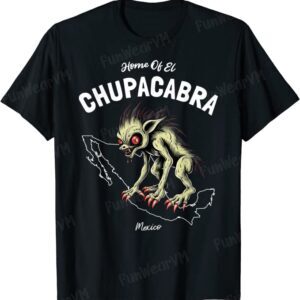 Home Of El Chupacabra Mexico Cryptid T-Shirt
Home Of El Chupacabra Mexico Cryptid T-Shirt -
 Cinco De Mayo El Chupacabra Cryptid Mexican Fiesta T-Shirt
Cinco De Mayo El Chupacabra Cryptid Mexican Fiesta T-Shirt -
 El Chupacabra Cryptid Creature El Mito La Leyenda T-Shirt
El Chupacabra Cryptid Creature El Mito La Leyenda T-Shirt -
 Cinco De Mayo El Chupacabra Cryptid Mexican Fiesta Drinko T-Shirt
Cinco De Mayo El Chupacabra Cryptid Mexican Fiesta Drinko T-Shirt -
 Home Of El Chupacabra Texas USA Cryptid T-Shirt
Home Of El Chupacabra Texas USA Cryptid T-Shirt -
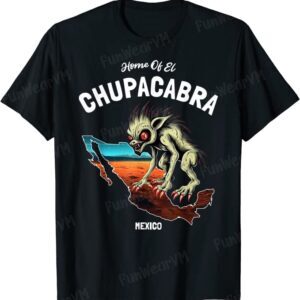 Home Of El Chupacabra Mexico Cryptid T-Shirt
Home Of El Chupacabra Mexico Cryptid T-Shirt -
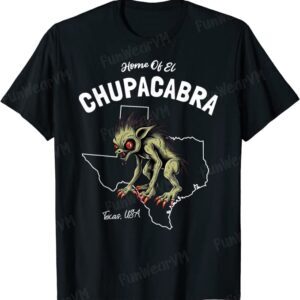 Home Of El Chupacabra Texas USA Cryptid T-Shirt
Home Of El Chupacabra Texas USA Cryptid T-Shirt -
 Home Of El Chupacabra Puerto Rico USA Cryptid T-Shirt
Home Of El Chupacabra Puerto Rico USA Cryptid T-Shirt -
 Coffee and Cryptids Bigfoot Mothman Chupacabra Wendigo Frog T-Shirt
Coffee and Cryptids Bigfoot Mothman Chupacabra Wendigo Frog T-Shirt -
 Coffee and Cryptids Bigfoot Mothman Chupacabra Wendigo Frog T-Shirt
Coffee and Cryptids Bigfoot Mothman Chupacabra Wendigo Frog T-Shirt -
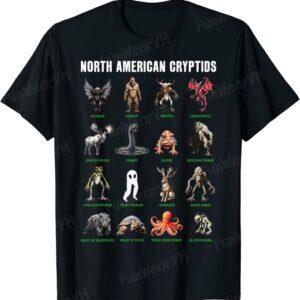 North American Cryptids Cryptozoology T-Shirt
North American Cryptids Cryptozoology T-Shirt -
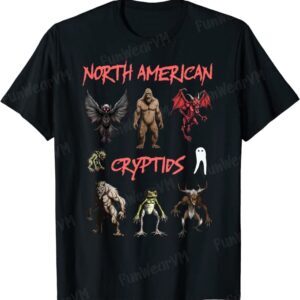 North American Cryptids Cryptozoology Research T-Shirt
North American Cryptids Cryptozoology Research T-Shirt -
 North American Cryptids Cryptozoology T-Shirt
North American Cryptids Cryptozoology T-Shirt
